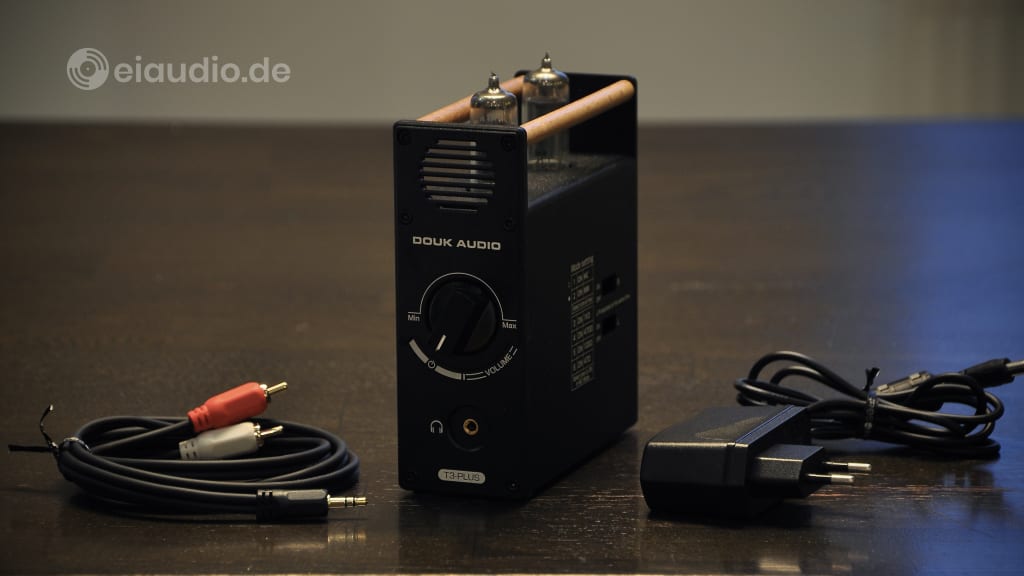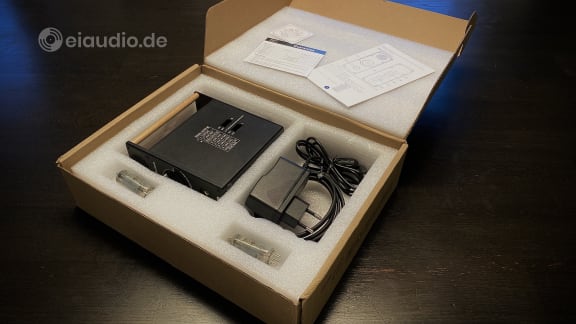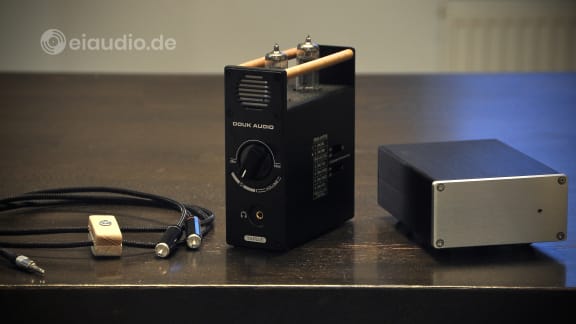Douk Audio T-3 Plus
Published: 16/11/2021
Manufacturing date: 2021
Author: Karsten Hein
Category: Gear & Review
Tag(s): Headphone Amps
“Is nothing sacred?” was the title of Salman Rushdie’s famous essay that he wrote in defence of his 1988 novel ‘The Satanic Verses’. As it so happened, his work of fiction had prompted Iran’s Ayatollah Khomeini to declare a worldwide ‘fatwa’ on Rushdie, which was, in essence, an order for the author to be killed. With his essay, Rushdie was hoping to mobilise sympathy for his train of thought, unfortunately, without much success. The author had to remain in hiding for years to come. As Rushdie pointed out in his essay, the question “Is nothing sacred?” is usually of rhetorical nature and posed in hope of reaffirming agreement or arousing mutual outrage, whenever an established system of belief is threatened by the careless non-believer: A church that is turned into a restaurant or discotheque. — Is nothing sacred?
This same question must have been on the mind of my friend and fellow audiophile Luigi, when he learnt that I was making preparations for an article on a cheap Chinese import preamp by the ‘eBay-brand’ Douk Audio. Considering the line-up of reputable audio devices presented on this website, my musings on the price-driven T-3 to the well-seasoned Hi-Fi connoisseur must have seemed like a wilful attempt at dismantling my credibility. “I don’t know anyone, who is serious about Hi-Fi and would consider making such a purchase” was his impromptu view of my endeavour.
I could understand his objections, of course. In purchasing audio legends from the past, we had the clear advantage of hindsight. Over their sometimes 40+ years of existence, the true gems of historical audio engineering stood out from the unworthy rest like beacons in the night. And, making purchases from one connoisseur to another, the true merits of each unit were mostl well documented, and the risk of making a financial loss was minimal. The sonic discoveries were glorious. Under the radar and far from the regular consumer claptrap, we found ourselves protected in the world of the informed. Why would I open Pandora’s box for a new and far away contender, when there was still so much of worthwhile history waiting to be rediscovered?
On the other hand, many of today’s legends started out as unorthodox price breakers in their own right. If you think of David Hafler, for example, and his affordable Heathkit audio gems, these, too, were in stark opposition to the more established (and pricier) Harman Kardon designs, and they were often frowned upon by the more established brands. Hafler’s designs earned their reputation and their eternal place in our hearts mostly based on their sonic virtues. In this context, it would be interesting to draw up a comparison between low-price engineering successes and their higher priced counterparts. There would ultimately be some surprises, because a product’s merits can best be gauged by how satisfactory it is to the owner over the course time. A point at which existing vintage models clearly have the upper hand.
Advert eiaudio/shop:
I came across the T-3 Plus when I was preparing to digitise records for a friend of mine. Charles had seen his record collection flooded in the recent heavy rainfalls and had decided to leave what he could salvage with me for restoration and safe-keeping. In return, he had asked me to create CD-quality files for him that he could store and play on his computer. Suddenly faced with this new task, I realised that I did not have a headphone amp that would allow me to match our 250 Ohm headphones with the sound card of my computer. At the time, I still had limited experience with headphones, dedicated headphone amps, or digitising records. Not a great starting point, except for those with the heart of an explorer. And so, I set out to search the web for a reasonably priced headphone amp, taking into consideration new and used units alike.
The T-3 Plus caught my attention because it had a fashionable Steampunk look about itself. It stood upright and combined both dark-brown metal and wooden elements. The industrial look was further highlighted by the tube sockets being conveniently located along its top. It also featured built-in RIAA correction for MM and MC turntables, the combination of which was rare among the smaller tube preamps. I was pleasantly surprised that it also featured micro-switches that would allow me to adapt its input to the exact specifications of the phono cartridge in use. OK, and it probably helped my decision that, after looking at the T-3 Plus just once, it continued to be displayed to me during my following searches. I could have cleared my cookies, but I decided that I did not mind. When I made the purchase I was fully aware that this might be considered blasphemy by the hard-core believer. To me it was an act of inquisitive playfulness at most.
The T-3 Plus arrived here well-packaged in a foamed box of organic grey cardboard with the words “Transmit nature music” written on it. Except for the poor English, nothing about the packaging suggested that this had been designed carelessly. The box contained the preamplifier, a set of Chinese 6A2 825M vacuum tubes, a cheap 1.5 ampere switching power supply, and one 3.5mm to RCA auxiliary interconnect. Unfortunately, both the interconnect and the power supply were of such poor sonic integrity that they would work against Douk Audio’s mission statement of transmitting natural music. — I also had a suspicion about the quality of the tubes, but I was willing to give them a try before making a decision about them.
Although T-3 Plus was of satisfactory build quality, I noticed that it was delivered without rubber feet that would help the unit stay in place in the event of a accidental tugging on the headphone cord. I still had some anti-slip feet available and attached them to the base. The front of the unit featured the 3.5mm headphone socket and a single knob for operation. Although I liked the idea of the power switch being part of the volume control, I did find the dial itself fragile. A bit more resistance would have been desirable. If given a choice, I would also have chosen larger headphone jacks over the smaller ones. The back of the T-3 Plus featured RCA/cinch sockets for phono with a massive gold-plated ground prong. I would have liked to see the same RCA/cinch standard as auxiliary input as well, rather than having to purchase a dedicated interconnect for a 3.5mm socket. Additionally, a manual selector between the two inputs would have been desirable, instead of giving the auxiliary signal automatic priority when connected.
I began my listening adventure with our trusted Denon DCD-1420 player as music source. The T-3 Plus was connected via its original accessories: the cheap interconnect, tubes, and power supply. Unsurprisingly, the music sounded flat and stale, lacking rhythm, excitement, etc. I compared the sound to our Denon’s onboard headphone amp and found the Denon to be far superior. I then understood that some major changes would be necessary in order to get this little headphone amp to shine — if it was possible at all. So, in true explorer spirit, I scanned the web for a linear power supply. Many of the supplies I found had displays that showed the mains voltage and similar futile information. For audiophile listening, I had to make sure that our power supply was free from noise factors. I also contacted Mr Becker and asked him to manufacture a 3.5mm to RCA interconnect for me. I wanted to make sure that I was listening to the headphone amp rather than the cable. We decided on a solid core silver interconnect with Elecaudio’s silver-plated tellurium-copper on the side of the source, and Oyaide’s P-3.5SR silver-plated rhodium plug on the side of the amp.
The power supply and interconnect arrived about three weeks later. I decided that I would give all parts a break-in time of at least 80 hours. To do so, I let our DCD-1420 play for a few hours each day, mostly during working time, in order to monitor the sonic development at a certain interval. While the linear transformer did improve bass response right from the start, the new silver interconnects laid bare some strange metallic sibilance in the treble that, once identified as such, troubled me each time I listened. And, while the T-3 Plus had matured in bass and rhythm, the Denon’s internal headphone amp still had the lead in terms of spacial and tonal accuracy. I was starting to be a little frustrated and suspected the tubes to be the culprit. Some research on the subject brought to light that Chinese 6A2 825M vacuum tubes can be purchased for 3.00 EUR a pair, whereas audiophile vacuum tubes rarely sell below ten times this amount for a matched pair. I was willing to expand my experience in ‘tube rolling’ and contacted Douk Audio for advice. They wrote back to me the following day, giving me a list of possible replacements: 6J1, 6J2, 6J5, 6K4, 6*1N, and 5654.
Since I was still a relative novice in the subject of vacuum tubes, I conducted another web search and came across an article by Rainer Uhlmann published on the audionist.de website, in which Rainer, a musician, described how different tubes affected the music in his listening setup. He explains his findings in such vivid terms that I, too, managed to get a good impression of the potential differences between them. The tubes used in his experiments were:
- Western Electric WE 403B
- RCA 5654 Command
- Mullard CV4010
- Raytheon JAN-CRP-5654
- General Electric JAN 5654W
- Voskhod 6Ж1П-EB (= 6ZH1P-EV o. 6J1P-EV)
- Ericsson 5591
From Rainer’s description, I shortlisted three tubes: Mullard CV4010, General Electric JAN 5654W, and Ericsson 5591. Looking for the most versatile performer, I ended up purchasing a matched pair of JAN 5654W tubes. Unfortunately, this meant having to leave the Mullard and Ericsson tubes for another project. As to my order, I was not sure what to make of the branding of the JAN 5654W tubes as 'General Electric'. The vendor was the Chinese Hi-Fi seller 'Nobsound' who operated on a similar basis as Douk Audio, showing their products mostly on AliExpress, eBay, and Amazon. I doubted that General Electric still made tubes. And the tubes did not look as though they were 'New Old Stock' (NOS), either. I assume that they were instead manufactured in China (like everything else these days), using old General Electric tube patents and designs. If you know more about this, your comment would be much appreciated.
On the day the new tubes arrived, I started listening straight away with great apprehension and was deeply disappointed to find that the metallic sibilance in the treble still remained. It seemed as if there was a tonal up-shift that affected the complete spectrum and caused the sound to be unnaturally bright. Since burning in the tubes for 80 hours had shown no effect on my previous setup, I was not very hopeful that I would see much of an improvement this time around. Still, I decided to give the headphone amp a final chance to shine. I let it play music for five hours a day over a period of five days and made a point not to listen during this time. When I finally returned for auditioning, I found that the JAN 5654W tubes proved less resistant to burn-in and showed a much-improved performance. The top-end had meanwhile become softer and developed a teasing warmth and affection. During passages in which I used to fear being attacked with the harsh sibilance of female vocals, I could now feel a playful attraction. The space between individual instruments had increased, and there was now sufficient sonic width and depth. I could see myself listening for fun and relaxation in this setup without having to suffer any harshness.
Before reaching the technical limits of the T-3 Plus headphone amp, I was able to hear the shortcomings of my monitor headphones. These were the older 300 Ohm Sennheiser HD580 from 1996 and the more recent 250 Ohm Beyerdynamic DT 990 PRO from 2021. Both of these could be classified as entry-level headphones, although the DT 990 PRO could also be found in professional studio applications. While the Sennheiser managed to hold the mid-band frequencies together and gave a more solid-sounding performance, it lacked bass extension and lost most of the delicate transients. The Beyerdynamic, on the other hand, had wonderful bass extension but was lacking mid-bass punch. It gave lots of room to transients and managed great instrument separation, perhaps at the cost of losing the performance as a homogenous whole. It seemed as some frequencies were purposefully muffled in order to give others prevalence, which resulted in a somehow muffled sound in which room aspects where missing.
I ended my exploration of Douk Audio’s T-3 Plus with mixed emotions. While the basic unit was available at an entry-level price, I found that serious audiophiles would need to invest at least twice this amount on the periphery to raise its performance to an acceptable level. Connectivity, as well, entailed some compromises that made this unit a niche product for very specific scenarios. In order to give you a definite verdict on T-3’s full capabilities, I would have needed to invest in equally as capable headphones, a shortcoming that I had yet been unaware of. Therefore, be sure to consider these factors in application before making a purchase, and then decide for yourself, how deep into the rabbit hole you are prepared to crawl. I certainly enjoyed the trip, perhaps because it was unorthodox and almost forbidden. And while doctrine would force us to make a choice between good and evil, loyalty or blasphemy, the open road of exploration meanders freely and ultimatley becomes an amalgamate of the two sides.
Note: For further exploration of Douk Audio’s T-3 Plus see my article on the Beyerdynamic T1 headphones which helped shed more light on the subject.
Specifications:
-
Type: Tube Headphone Amplifier / Preamplifier
-
Audio inputs: RCA phono / 3.5mm Auxiliary
-
Audio outputs: 3.5mm headphone / RCA stereo
Auxiliary Input
-
AUX input level: 1V
-
RCA output level: 2V (max.)
-
Frequency response: 20 -20.000 Hz, -1dB
-
Total harmonic distortion: 0.01%
-
Signal to noise ratio: 100dB
Phono Input
-
Phono input: 0.005V
-
RCA output: MM = 530mW (max.) / MC = 5V
-
RIAA correction
-
Total harmonic distortion: 0.2%
-
Signal to noise ratio: 89dB
Headphones
-
Headphone output: 130mW@32Ω
-
Headphone impedance: 32-300Ω
-
Operating voltage: DC 12V
-
Dimensions: v(W) 50mm; (D) 120mm; (H) 138mm
-
Weight: 540g / 1.19lb
-
Year: 2021






